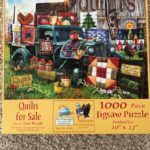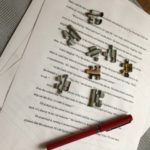
Last week, I wrote about the preliminary steps in writing a mystery: coming up with an idea, thinking about the characters, imagining their back stories, and doing necessary research. Except for research, those steps involve mostly thinking. Research is a hands-on process. These parts of mystery writing are akin to sorting out the pieces of a jigsaw puzzle and arranging some pieces in a group of like pieces—say, the sky.
 This week, I’m ready to organize the puzzle more completely. The border pieces with at least one straight edge must be sorted out and placed together. Now, I’m providing a framework for the puzzle. Which part is the top? Which parts are the sides and bottom? It still takes some thinking and recognition of the way the pieces will fit together into a whole picture. Fortunately, a jigsaw puzzle often has a picture on the box, so you have something to consult. Unfortunately, when you’re writing a book, you’re going it alone—no picture, alas, unless you’re a visual learner and can see the entire puzzle in your head.
This week, I’m ready to organize the puzzle more completely. The border pieces with at least one straight edge must be sorted out and placed together. Now, I’m providing a framework for the puzzle. Which part is the top? Which parts are the sides and bottom? It still takes some thinking and recognition of the way the pieces will fit together into a whole picture. Fortunately, a jigsaw puzzle often has a picture on the box, so you have something to consult. Unfortunately, when you’re writing a book, you’re going it alone—no picture, alas, unless you’re a visual learner and can see the entire puzzle in your head.
As I research and think about the characters’ back stories and the book’s focus, I also begin to understand how pieces of the border come together. In my first mystery, Three May Keep a Secret, I began the story by introducing the town and the group of friends who surround my main character, Grace Kimball. That was my focus for the opening of the story. However, as I  thought about that in the structure of the novel, I decided I needed a bit of ominous foreshadowing. That led me to introduce the victim of the first murder. Brenda Norris didn’t make a positive impression on the readers, and after she left that first scene, Grace’s friends had a few choice comments to make about her and what her possible future might be. They were right. That was a border piece that I pushed in at the last moment, and it fit.
thought about that in the structure of the novel, I decided I needed a bit of ominous foreshadowing. That led me to introduce the victim of the first murder. Brenda Norris didn’t make a positive impression on the readers, and after she left that first scene, Grace’s friends had a few choice comments to make about her and what her possible future might be. They were right. That was a border piece that I pushed in at the last moment, and it fit.
When I first thought about writing a mystery, I worried about how it would all fit together. I decided to do what I’ve always done to solve a problem: try a little research. I bought several cozy mysteries, outlined their main events, and considered how they fit in the scheme of things. After that idea, I bought a copy of K.M. Weiland’s Structuring Your Novel. I had read her ideas on her website, and they made sense to me. She divides the plot structure into percentages. At this percent, this should happen, etc. I loved her precise understanding of what readers expect as they understand stories and have certain expectations. That worked. It made the border of my puzzle much easier to figure out.
 More recently, I read Jane Cleland’s Mastering Suspense, Structure, and Plot and studied how she had used her organization pattern in her Josie Prescott mysteries. Her road map for organizing is somewhat like K.M. Weiland’s, but she uses pages, main plot, and subplots. Like Weiland, she organizes around major events. I’m not going to give away her plan, but I find that it makes absolute sense to me. In between those major events, the writer develops her subplots. If this all sounds very clinical, I have to say it’s a great way to write from point to point. And it works. Cleland believes this keeps the pace up, and she is correct. Just read one of her mysteries.
More recently, I read Jane Cleland’s Mastering Suspense, Structure, and Plot and studied how she had used her organization pattern in her Josie Prescott mysteries. Her road map for organizing is somewhat like K.M. Weiland’s, but she uses pages, main plot, and subplots. Like Weiland, she organizes around major events. I’m not going to give away her plan, but I find that it makes absolute sense to me. In between those major events, the writer develops her subplots. If this all sounds very clinical, I have to say it’s a great way to write from point to point. And it works. Cleland believes this keeps the pace up, and she is correct. Just read one of her mysteries.
Now the border of the jigsaw puzzle (and the structure of the mystery) are in order. With a jigsaw puzzle, I’m not going to change the border unless I find a piece out of place. However, with a mystery structure, I am more apt to make some changes as I go along and discover a piece that won’t fit.
Next, I need to fill in the areas of the story outline with details. This means I will begin writing chapters of my new mystery, filling in ideas and rearranging things to work with my outline. With the jigsaw puzzle, this means working on specific areas of the puzzle: the sky, the barn, the quilts, and the signs. With my novel, it means working on specific areas of the plot: the beginning, the major turning points, the climax, and the end.
If you’re a lover of jigsaw puzzles, the one above by artist Tom Wood can be found at Sun’s Out!



Great series so far Susan! I can’t believe you actually dissected mysteries before writing. That’s research! I can tell you used to be a teacher 🙂
Oh, my gosh. You made me laugh so hard with that comment about being a teacher. It is a curse I carry: structure, outlining, research. You are so right. I guess whatever works, and I often must laugh also, because the strategies I use are definitely based on my personality. You can run but you can’t hide.
Excellent blog post, Susan.
Thank you, Louise.